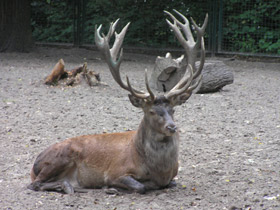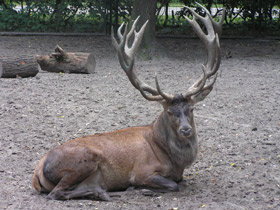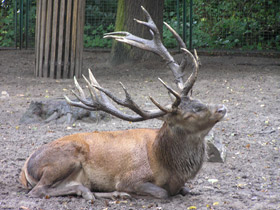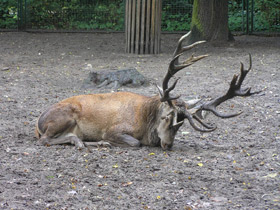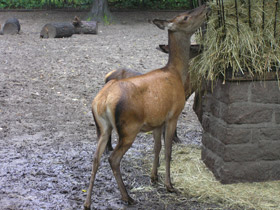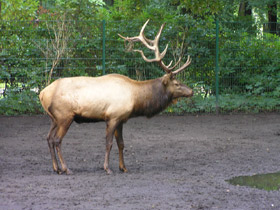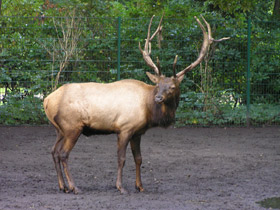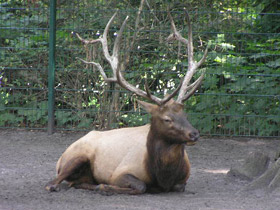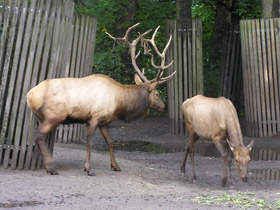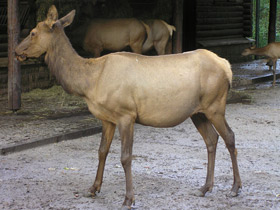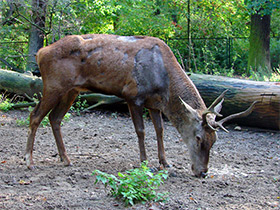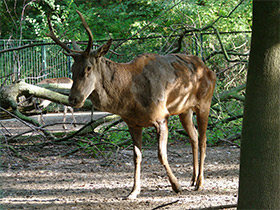The red deer (Cervus elaphus)
The red deer is 200 to 270 cm long and stands at 130 to 150 cm at the shoulders. Adult deer have grey, brown or reddish coat without light spots on the sides. Like many other deer species, the red deer has a special pale patch on the rear that helps the deer to see each other in the dense forest. In the red deer this patch spreads over the tail and has brownish tint. The antlers in adult males are very large and have many tines. The red deer inhabit light forests with dense understory and clear cuts. They are also found in natural grasslands and pastures and may spend summers in alpine meadows. In summer, the red deer are active in early mornings and late evenings but may forage during the day in cloudy weather. In very hot days, these deer often come into water or lie on the patches of unmelted snow. In winter, especially during the periods of strong frost, red deer may forage through the whole day. These deer can hardly move through deep snow and when the depth of the snow cover reaches 50 to 70 cm, the size of the red deer home range decreases from 4-6 to 0.66-1 squire km. If the snow is even deeper than one meter, red deer gather in large groups within small areas of the forest penetrated with dense net of deer trails. If this deer gathering is discovered by predators, all the deer in the herd might end up with being killed by the spring time. In summer, the herd consists of 3 to 10 individuals including older female and her offspring born in the last few years. Stags are solitary or gather into unrelated bachelor groups. As the fall mating season approaches, males form harems of 2 to 15 females. These groups separate in spring. Red deer are feeding on grasses, fallen acorns, nuts, fruits, bush and tree leaves, mushrooms and berries in summer, and tree bark, shoots, and needles of coniferous trees in the winter months. The mating season (“rut”) of red deer starts in early autumn, with the bulls being especially active in the cold clear days; the roars of the males in such days could be heard from the distance of 5 or even 10 kilometres. During rutting the males drink a lot of water, do not eat and lose much of their body weight. Fights between dominant males and intruders can be intense, the sounds produced by the antlers banging together carry over hundreds of meters and all the bushes and grass around the fighting site are sometimes completely trampled down. Sometimes the deer break their antlers in the fight but usually males just “size each other up” without violence. The male red deer shed their antlers in March or April, and shortly after that start growing new antlers that become fully grown by the middle of summer. By autumn the stags rub their antlers against tree trunks to shed skin. Females in their second or third autumn can produce one or very rarely two offspring. The gestation period is 8 to 8.5 months. During the first days of its life the fawn quietly lies in the dense grass, with its mother foraging in a distance in order to not attract predators. After 7 to 10 days, fawns are able to follow their mothers and try grasses but they are not weaned until winter.
The red deer is a valued subject of sport hunting. These animals are bred at the deer farms for their velvet. Although cutting off the velvety antlers is a very painful procedure, the deer recover quickly and may even breed in next mating season.

















